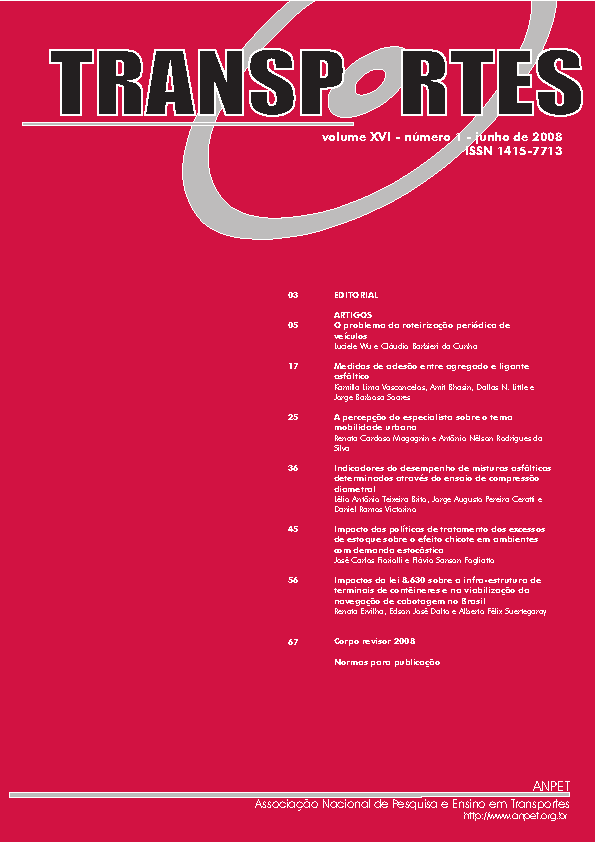Medidas de adesão entre agregado e ligante asfáltico
DOI:
https://doi.org/10.14295/transportes.v16i1.9Resumo
A adesão entre agregado e ligante asfáltico vem sendo apontada como uma propriedade de grande importância para a causa de defeitos encontrados em pavimentos asfálticos, tais como trincas por fadiga, e dano por umidade. Diferentes mecanismos existem na literatura para explicar a adesão entre os dois materiais, porém, estes mecanismos podem ser resumidos em três grandes grupos: inter- travamento mecânico, adesão física, e interação química. A ocorrência de mais de um mecanismo simultaneamente parece ser o fenô- meno mais provável, sendo a relevância de cada um dependente das características físicas e químicas do agregado e do ligante asfálti- co. No presente trabalho, dois procedimentos foram utilizados para acessar a adesão entre agregado e ligante. O primeiro constou do cálculo do trabalho de adesão através da energia livre de superfície dos materiais envolvidos e o segundo, da determinação da entalpia de imersão quando soluções de asfalto são postas em contato com o agregado. Todos os materiais usados foram provenientes da biblio- teca de referência do SHRP sendo um pedregulho como agregado, e três diferentes ligantes asfálticos. Os resultados mostraram a capa- cidade do microcalorímetro em detectar possíveis interações químicas na adesão entre agregado e ligante asfáltico, em conjunto com adesão física. A presença de grupos funcionais mais fortemente adsorvidos pela superfície dos agregados justificou os maiores valores de entalpia de imersão para as combinações onde esses grupos se encontravam presentes.
Abstract Adhesion between the asphalt binder and the aggregate is critical to the performance and durability of asphalt mixtures. According to the literature, distresses mechanisms such as fatigue cracking and moisture induced damage are correlated to the nature and quality of adhesion between these two materials. Different mechanisms already exist to explain adhesion, but they can be summa- rized in three main groups: mechanical interlocking, physical adhesion and chemical interaction. Although discussions of isolated theo- ries and mechanisms help to clarify the understanding of adhesion, they can rarely be separated completely to each other. The physical and chemical characteristics of asphalt and aggregate will in fact determine the relevance of each of these mechanisms. This study presents the results of two procedures for adhesion measurement: (i) an indirect method based on the surface free energy components of asphalt binder and aggregate; and (ii) the determination of the enthalpy of immersion through the use of a microcalorimeter. The materials used, a gravel as aggregate and three different neat asphalts, were provided by the Strategic Highway Research Program's Material Reference Library. The results showed the capacity of the microcalorimeter in detecting possible chemical reactions together with physical adhesion. The presence of functional groups more strongly adsorbed by the aggregate surface justified the higher values of the heat of immersion.
Downloads
Downloads
Publicado
Como Citar
Edição
Seção
Licença
Ao submeter um manuscrito para publicação neste periódico, todos os seus autores concordam, antecipada e irrestritamente, com os seguintes termos:
- Os autores mantém os direitos autorais e concedem à Transportes o direito de primeira publicação do manuscrito, sem nenhum ônus financeiro, e abrem mão de qualquer outra remuneração pela sua publicação pela ANPET.
- Ao ser publicado pela Transportes, o manuscrito fica automaticamente licenciado sob a Licença Creative Commons CC BY 4.0. Esta licença permite o seu compartilhamento com reconhecimento da autoria e da publicação inicial neste periódico.
- Os autores têm autorização para assumir contratos adicionais separadamente, para distribuição não exclusiva da versão do trabalho publicada neste periódico (por ex.: publicar em repositório institucional ou como capítulo de livro), com reconhecimento da publicação inicial na Transportes, desde que tal contrato não implique num endosso do conteúdo do manuscrito ou do novo veículo pela ANPET.
- Os autores têm permissão e são estimulados a publicar e distribuir seu manuscrito online (por ex.: em repositórios institucionais ou na sua página pessoal) depois de concluído o processo editorial. Como a Transportes é de acesso livre, os autores são estimulados a usar links para o DOI do artigo nesses casos.
- Os autores garantem ter obtido a devida autorização dos seus empregadores para a transferência dos direitos nos termos deste acordo, caso esses empregadores possuam algum direito autoral sobre o manuscrito. Além disso, os autores assumem toda e qualquer responsabilidade sobre possíveis infrações ao direito autoral desses empregadores, isentando a ANPET e a Transportes de toda e qualquer responsabilidade neste sentido.
- Os autores assumem toda responsabilidade sobre o conteúdo do manuscrito, incluindo as devidas e necessárias autorizações para divulgação de dados coletados e resultados obtidos, isentando a ANPET e a Transportes de toda e qualquer responsabilidade neste sentido.










